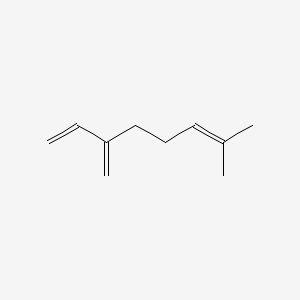| Authors | Title | Published | Journal | PubMed Link |
|---|---|---|---|---|
| Macchioni F et al. | Acaricidal activity of pine essential oils and their main components against Tyrophagus putrescentiae, a stored food mite. | 2002 | J. Agric. Food Chem. | pmid:12137480 |
| Minh Tu NT et al. | Characteristic odor components of Citrus sphaerocarpa Tanaka (Kabosu) cold-pressed peel oil. | 2002 | J. Agric. Food Chem. | pmid:11982418 |
| Caballero-Gallardo K et al. | Repellent activity of essential oils and some of their individual constituents against Tribolium castaneum herbst. | 2011 | J. Agric. Food Chem. | pmid:21291237 |
| Barra A et al. | Characterization of the volatile constituents in the essential oil of Pistacia lentiscus L. from different origins and its antifungal and antioxidant activity. | 2007 | J. Agric. Food Chem. | pmid:17658828 |
| Choi HS | Characteristic odor components of kumquat (Fortunella japonica Swingle) peel oil. | 2005 | J. Agric. Food Chem. | pmid:15740053 |
| Matsuura R et al. | Tyrosinase inhibitory activity of citrus essential oils. | 2006 | J. Agric. Food Chem. | pmid:16536612 |
| Jouenne E and Crouzet J | Effect of pH on retention of aroma compounds by beta-lactoglobulin. | 2000 | J. Agric. Food Chem. | pmid:10775385 |
| Umano K et al. | Volatile chemicals identified in extracts from newly hybrid citrus, dekopon (Shiranuhi mandarin Suppl. J.). | 2002 | J. Agric. Food Chem. | pmid:12207474 |
| Choi HS et al. | Characterization of the odor-active volatiles in citrus Hyuganatsu (Citrus tamurana Hort. ex Tanaka). | 2001 | J. Agric. Food Chem. | pmid:11368611 |
| Schaneberg BT and Khan IA | Comparison of extraction methods for marker compounds in the essential oil of lemon grass by GC. | 2002 | J. Agric. Food Chem. | pmid:11879000 |
| Bylaite E et al. | Dynamic deadspace-gas chromatography-olfactometry analysis of different anatomical parts of lovage (Levisticum officinale Koch.) at eight growing stages. | 2000 | J. Agric. Food Chem. | pmid:11312790 |
| Pino JA et al. | Volatile compounds of Psidium salutare (H.B.K.) Berg. fruit. | 2002 | J. Agric. Food Chem. | pmid:12188621 |
| Leung JC et al. | Direct, redox-neutral prenylation and geranylation of secondary carbinol C-H bonds: C4-regioselectivity in ruthenium-catalyzed C-C couplings of dienes to α-hydroxy esters. | 2012 | J. Am. Chem. Soc. | pmid:22985393 |
| Shibahara F et al. | Diene hydroacylation from the alcohol or aldehyde oxidation level via ruthenium-catalyzed C-C bond-forming transfer hydrogenation: synthesis of beta,gamma-unsaturated ketones. | 2008 | J. Am. Chem. Soc. | pmid:18841895 |
| Estell RE et al. | Effects of cis-beta-ocimene, cis-sabinene hydrate, and monoterpene and sesquiterpene mixtures on alfalfa pellet intake by lambs. | 2008 | J. Anim. Sci. | pmid:18272857 |
| Estell RE et al. | Effects of four mono- and sesquiterpenes on the consumption of alfalfa pellets by sheep. | 2002 | J. Anim. Sci. | pmid:12542171 |
| Hammer KA et al. | Antifungal activity of the components of Melaleuca alternifolia (tea tree) oil. | 2003 | J. Appl. Microbiol. | pmid:12969301 |
| Brodkorb D et al. | Linalool dehydratase-isomerase, a bifunctional enzyme in the anaerobic degradation of monoterpenes. | 2010 | J. Biol. Chem. | pmid:20663876 |
| Croteau R and Satterwhite DM | Biosynthesis of monoterpenes. Stereochemical implications of acyclic and monocyclic olefin formation by (+)- and (-)-pinene cyclases from sage. | 1989 | J. Biol. Chem. | pmid:2768265 |
| Bohlmann J et al. | Monoterpene synthases from grand fir (Abies grandis). cDNA isolation, characterization, and functional expression of myrcene synthase, (-)-(4S)-limonene synthase, and (-)-(1S,5S)-pinene synthase. | 1997 | J. Biol. Chem. | pmid:9268308 |
Myrcene
Myrcene is a lipid of Prenol Lipids (PR) class. Myrcene is associated with abnormalities such as Hypomenorrhea, abnormal fragmented structure, Nephrosis, Renal tubular disorder and Kidney Diseases. The involved functions are known as Anabolism, Gene Expression, Protein Biosynthesis, Mutation and Selection, Genetic. Myrcene often locates in Plastids, Proboscis, Body tissue, Clone and soluble. The associated genes with Myrcene are TTPA gene, monoterpene synthase, Genome, 4S-limonene synthase and Homologous Gene. The related lipids are Pinene, Octanols, Membrane Lipids and Fatty Acids, Unsaturated.
Cross Reference
Introduction
To understand associated biological information of Myrcene, we collected biological information of abnormalities, associated pathways, cellular/molecular locations, biological functions, related genes/proteins, lipids and common seen animal/experimental models with organized paragraphs from literatures.
What diseases are associated with Myrcene?
Myrcene is suspected in Nephrosis, Kidney Diseases, Dehydration, Hypomenorrhea, Renal tubular disorder and other diseases in descending order of the highest number of associated sentences.
Related references are mostly published in these journals:
| Disease | Cross reference | Weighted score | Related literature |
|---|
No disease MeSH terms mapped to the current reference collection.
PubChem Associated disorders and diseases
What pathways are associated with Myrcene
There are no associated biomedical information in the current reference collection.
PubChem Biomolecular Interactions and Pathways
Link to PubChem Biomolecular Interactions and PathwaysWhat cellular locations are associated with Myrcene?
Visualization in cellular structure
Associated locations are in red color. Not associated locations are in black.
Related references are published most in these journals:
| Location | Cross reference | Weighted score | Related literatures |
|---|
What functions are associated with Myrcene?
Related references are published most in these journals:
| Function | Cross reference | Weighted score | Related literatures |
|---|
What lipids are associated with Myrcene?
Related references are published most in these journals:
| Lipid concept | Cross reference | Weighted score | Related literatures |
|---|
What genes are associated with Myrcene?
Related references are published most in these journals:
| Gene | Cross reference | Weighted score | Related literatures |
|---|
What common seen animal models are associated with Myrcene?
There are no associated biomedical information in the current reference collection.
